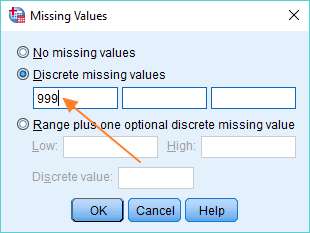
In SPSS the result of a logical expression is in fact true, false or missing. Users can still use the GSS data in SPSS by importing the Stata and SAS files however, SPSS users should be aware that all missing values (DK, NA, IAP, and the new missing values added in 2020) will be automatically recoded to SYSMIS (.) in SPSS after importing. In this simple example, variable B will get a value of 10, if A1, otherwise B is assigned a value of 20, but only for valid values for user missing or system missing cases, the result will be SYMIS. This makes the total number of missing values in the GSS data exceed the maximum of three missing values allowed in SPSS. Moreover, we have added new missing codes resulting from adaptation implemented to the 2020 GSS: the skip on the web mode (.s), and the unavailability in given years (.y) or current release of the data (.x). In other popular software, such as Stata and SAS, it is easy to use the same missing codes (.d. The SPSS format has a limitation in missing value assignments that makes difficult to implement consistent missing values. Also, missing data may reduce the precision of calculated statistics because there is less information than originally planned. If cases with missing values are systematically different from cases without missing values, the results can be misleading. Missing value, you get this: IF v1=$sysmis v2=$sysmis.Starting with the 2020 GSS (panel and cross sectional data), the GSS team no longer provides updates to the SPSS version of the GSS data file. I find the three variable definitions that I use the most are defining Variable Labels, Value Labels and Missing Data codes. Missing value analysis helps address several concerns caused by incomplete data. Searching for cases where v1 is equal to the system
#MISSING VALUES SPSS CODE WINDOWS#
Click on the Window menu located on the Menu bar, and a list of all currently open windows will appear. You can use the variable $sysmis only as a value youĬannot use it in the actual conditional statement. 4.4 Missing Values in SPSS Final Tip for Section 4: Moving from One Window to Another If more than one window is open in SPSS, it is possible to switch back and forth between them from the Menu bar. For example, suppose you have two variablesĬases of v2 to be equal to the system missing value where ForĮxample, if you want to generate the variable temp, whichĮquals the system missing value, the syntax would look like this: COMPUTE temp = $sysmis.Ī more common scenario would be to use this variable in a conditional If statement, as you would any other variable name. missing values to be applied to the ame, using the same syntax as value in navalues(df). You can include this in a compute statement or in an name-value pairs of missing values (see examples). Your skipped questions would then get the first one. In SPSS, $sysmis is the name of the system missing value. I had imagined that your case was one motivation for SPSSs distinction between user missing data (when you assign some values 9999 or similar) and user missing data (represented by the period).

Information here may no longer be accurate, and links may no longer be available or reliable. A single range using the keyword THRU (e.g. For example, suppose you have two variables (v1 and v2), and you wish to recode all cases of v2 to be equal to the system missing value where v1 is also system missing.

For example if you have survey data where you ask only females one or more question about pregnancy, and for males you omit those questions, in variables males would have there system missing 'values' (i.e. A comma separated list of up to three distinct (discrete) values. A more common scenario would be to use this variable in a conditional statement. Answer (1 of 2): System missing values in SPSS correspond to NULL value in databases.
< spec> is a list of codes to be declared missing several forms are available.This content has been archived, and is no longer maintained by Indiana University. MI in SPSS Set up/Review Assign missing values for all variables MISSING VALUES SexP DeptP AnxtP GSItP DeptS AnxtS GSItS SexChild Totbpt (-9). Declares user missing values for the listed variables.


 0 kommentar(er)
0 kommentar(er)
